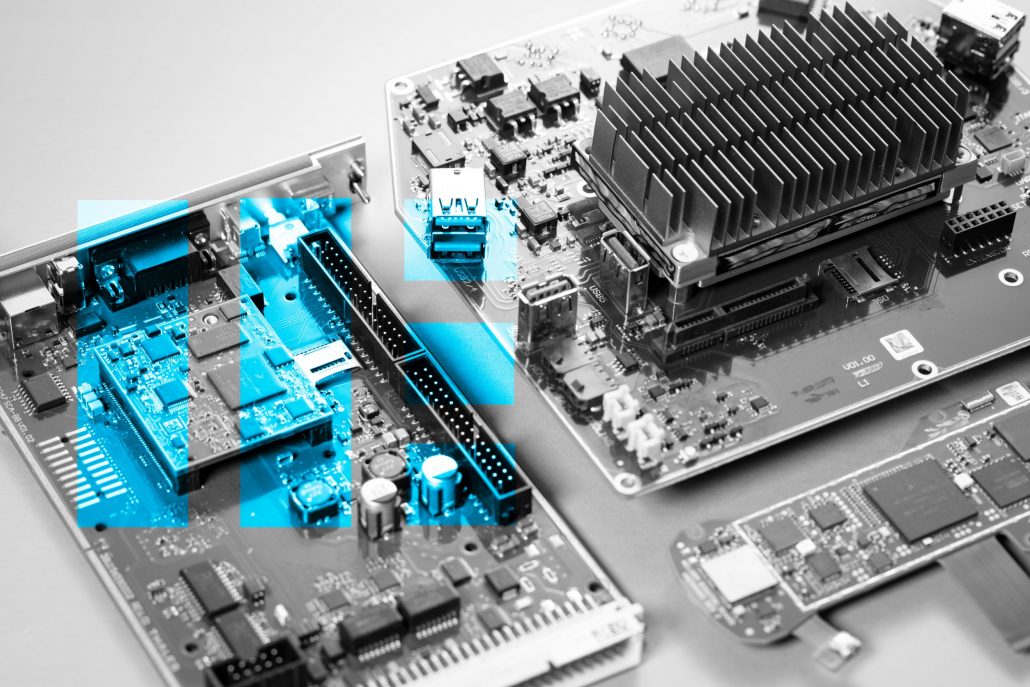What are Embedded Systems?
Embedded Systems – Highly-efficient Specialists
Our Motto: “We embed advanced technologies … like ears, eyes, voice and a brain.”
Embedded in our everyday lives
Embedded systems are all around us. They make our lives easier and we trust them to work, without giving them much thought or, for some, knowing that they are there in the first place. Embedded systems are hidden inside (“embedded”) in our smartphones and tablets and can be found in our cars and even in household appliances. They also play a big part in industrial, telecommunications, transportation, medical or military applications and are associated with automation and digital transformation of organizations.
Bringing Hardware to Life
You can imagine embedded systems as the brain of a device. Their function usually is to monitor and control a higher-level system. They can e.g. collect data and control machinery. Due to the low general awareness of their importance and because they are at the heart of many applications (inextricably built into larger mechanical or electronic systems and machines), embedded systems must be absolutely reliable and constantly available over long life cycles.
Embedded systems are a combination of hardware, software and mechanical components, which are closely interdependent and must be integrated with each other. Their complexity ranges between low, consisting of a single microcontroller chip, and very high, using several units, peripherals and networks inside one housing. Therefore, it is recommended that hardware and software engineers work together in a cross-functional team, especially during the design process, to ensure that all elements are compatible and perfectly integrated with each other
Embedded Hardware
Every electronic system needs a hardware platform to run on. The hardware will most likely be based on a microprocessor (CPU only) or microcontroller (CPU and integrated memory or peripheral devices on one chip). Components are chosen in accordance with the requirements and specifications of the design.
Embedded Software
Embedded software (sometimes also referred to as firmware) is needed to control the functions of a system or device. It is usually specialized for a particular hardware that it runs on and can be very simple or highly sophisticated. In most cases, time and memory constraints have to be taken into account. Moreover, functions are often controlled via machine interfaces (M2M) instead of human interfaces (HMI).
Characteristics of Embedded Systems:
- Size / space requirement
- Ruggedness against environmental factors (high or low temperatures, humidity, vibrations/shock)
- Power supply (e.g. battery for handheld/mobile or stationary devices)
- Costs

Embedded Systems as Highly-specialized Computers
Embedded systems are highly efficient specialists. In contrast to a generalist computer, which can perform a large variety of different tasks (but is also expensive and bulky), they are developed with a specific predefined task or set of tasks in mind, therefore saving costs (low cost per-unit) and valuable space (for example in mobile devices). Their hardware or programming are rarely changed over long time periods and require low maintenance, their power consumption is also very low, which makes them suitable also for battery-powered devices. Moreover, they can be optimized for rugged operating conditions.
Embedded systems have been around for many years. Their importance and sheer number are steadily increasing, forming a considerable market, especially with the rise of machine learning, artificial intelligence and internet of things (IoT) applications.
Mission-critical Systems
Embedded systems are often mission-critical. This means, they are vital for day-to-day operations of a company or organization. When they fail or are interrupted, business operations are significantly impacted. They are also often safety-critical, and their failure can cause serious damage to the environment and even lead to injuries or loss of life. Moreover, they can be security-critical when sensitive data is involved. Therefore, they have to be protected against unauthorized access or manipulation.
Real-time Performance
Many embedded systems have real-time constraints that must be met, which means they must guarantee a response within a specified time frame. Missing this deadline has consequences, that can sometimes be serious (e.g., think of an airbag which opens only a moment too late). If this is the case, they are also referred to as “reactive” because their purpose is to react to signals from their environment. Input devices typically include sensors or actuators.
What we can do for you
With Mission Embedded as your partner you can make your digital transformation and automation projects a reality. We specialize in software/hardware co-design and development, and support you from the initial idea, to the concept and realization of the application, to production and maintenance of the final product. Our software and hardware experts provide in-depth expertise and many years of experience gained in a large variety of projects in different markets such as transportation, aerospace, industry, public safety and defense.
Benefit from a one-stop-shop for all parts of your application: mechanics and housing, (base)board, Board Support Package, hardware optimized signal/data processing, operating system, system, and networking services.

